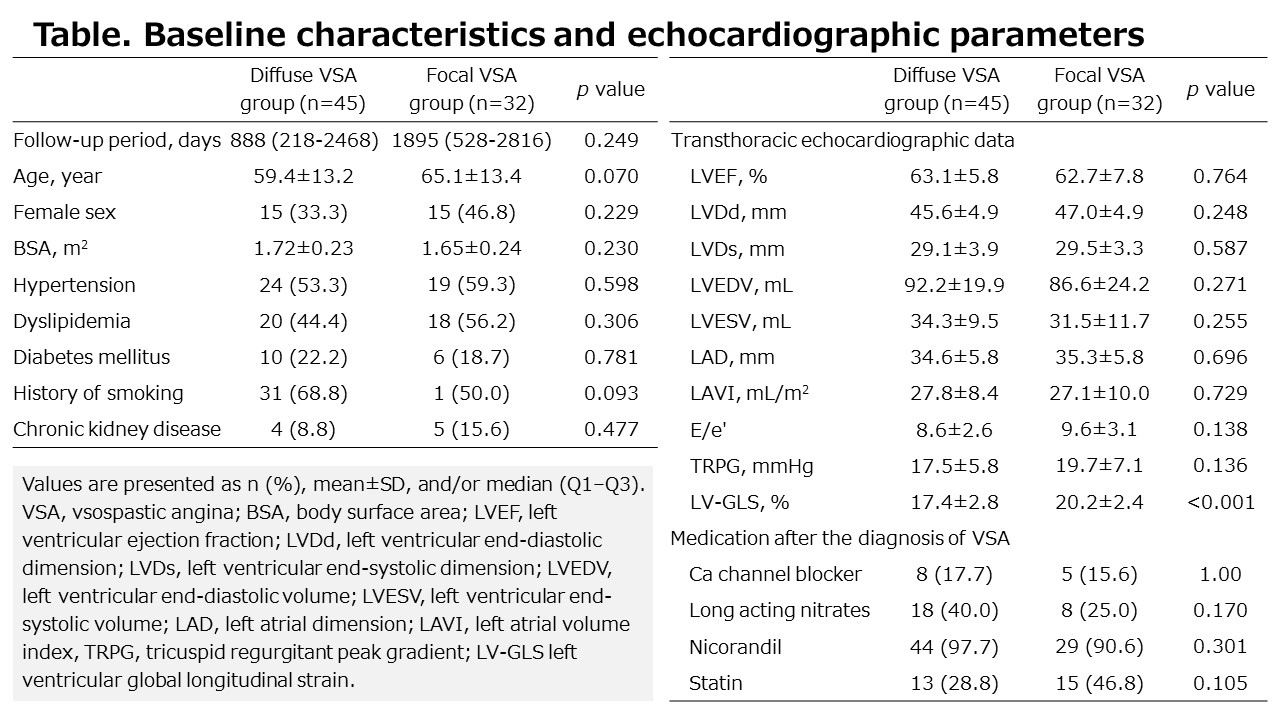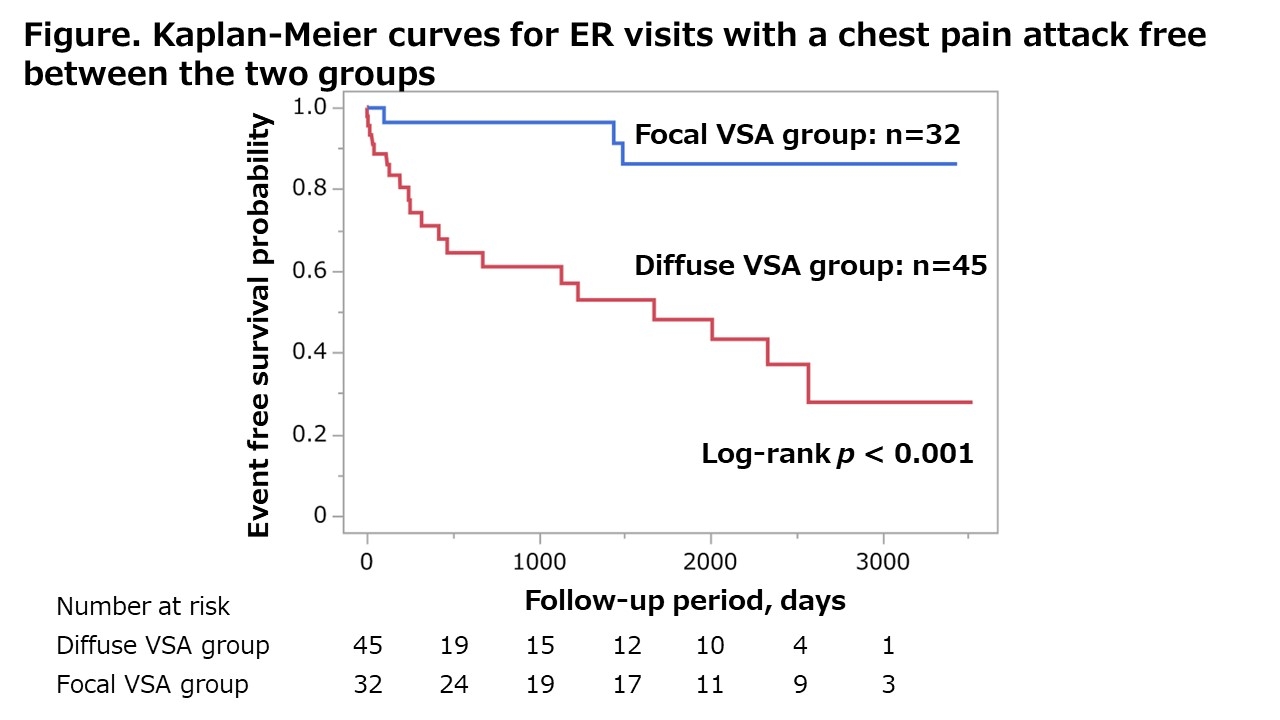Final ID: Su4135
Differences in Echocardiographic Findings Between Epicardial Vasospastic Angina Phenotypes Affect Response to Medical Therapy
Abstract Body (Do not enter title and authors here): Background
The phenotype of epicardial vasospasm is classified as focal or diffuse. However, its echocardiographic characteristics are unknown. Furthermore, patients with diffuse vasospasms have poorer responses to medical therapy than patients with focal spasms because of more extensive areas of endothelial dysfunction. We hypothesized that there are differences in echocardiographic findings between the patients with diffuse and focal vasospasm, which might affect response to medical therapy.
Methods
The present study was a single-center retrospective cohort study that included 77 consecutive patients diagnosed with vasospastic angina (VSA) undergoing coronary spasm provocation test using acetylcholine from 2014 to 2024. The patients with a history of cardiomyopathy and significant obstructive coronary artery disease were excluded. Diffuse VSA was defined as vasospasm in 2≧ adjacent coronary segments, and focal VSA was defined as vasospasm in one isolated coronary segment. Patients were divided into diffuse VSA group (n=45) and focal VSA group (n=32). Left ventricular function was assessed using 2D speckle tracking echocardiography. After the diagnosis of VSA and the administration of medical treatment for VSA, an emergency room (ER) visit with a chest pain attack was recorded as the event of poor response to medical therapy.
Results
There was no significant difference in the follow-up period and baseline characteristics (Table). LVEF was similar between the two groups (63.1±5.8% vs. 62.9±7.6%, p=0.87). In contrast, the left ventricular global longitudinal strain (LV-GLS) was significantly lower in the diffuse VSA group than in the focal VSA group (17.4±2.8% vs. 20.2±2.4% p<0.001). There is no difference in medical therapy for VSA (Table). Observation of ER visits with a chest was more frequent in the diffuse VSA group [diffuse VSA group (20/45, 44.4%) vs. focal VSA group (3/29, 9.3%), p<0.001]. Kaplan-Meier curves showed that the diffuse VSA group had a higher cumulative rate of ER visits with a chest pain attack (Log-rank p<0.001). On multivariable Cox regression analysis, diffuse VSA (HR=4.2, 95% CI: 1.10-16.06, p=0.030) and low LV-GLS (HR =1.16, 95%CI: 1.01-1.34, p=0.031) were an independent risk factor for poor response to medical therapy.
Conclusion
Patients with diffuse VSA had lower LV-GLS than patients with focal VSA. Moreover, diffuse VSA and lower LV-GLS were associated with poor response to medical therapy after diagnosis of VSA.
The phenotype of epicardial vasospasm is classified as focal or diffuse. However, its echocardiographic characteristics are unknown. Furthermore, patients with diffuse vasospasms have poorer responses to medical therapy than patients with focal spasms because of more extensive areas of endothelial dysfunction. We hypothesized that there are differences in echocardiographic findings between the patients with diffuse and focal vasospasm, which might affect response to medical therapy.
Methods
The present study was a single-center retrospective cohort study that included 77 consecutive patients diagnosed with vasospastic angina (VSA) undergoing coronary spasm provocation test using acetylcholine from 2014 to 2024. The patients with a history of cardiomyopathy and significant obstructive coronary artery disease were excluded. Diffuse VSA was defined as vasospasm in 2≧ adjacent coronary segments, and focal VSA was defined as vasospasm in one isolated coronary segment. Patients were divided into diffuse VSA group (n=45) and focal VSA group (n=32). Left ventricular function was assessed using 2D speckle tracking echocardiography. After the diagnosis of VSA and the administration of medical treatment for VSA, an emergency room (ER) visit with a chest pain attack was recorded as the event of poor response to medical therapy.
Results
There was no significant difference in the follow-up period and baseline characteristics (Table). LVEF was similar between the two groups (63.1±5.8% vs. 62.9±7.6%, p=0.87). In contrast, the left ventricular global longitudinal strain (LV-GLS) was significantly lower in the diffuse VSA group than in the focal VSA group (17.4±2.8% vs. 20.2±2.4% p<0.001). There is no difference in medical therapy for VSA (Table). Observation of ER visits with a chest was more frequent in the diffuse VSA group [diffuse VSA group (20/45, 44.4%) vs. focal VSA group (3/29, 9.3%), p<0.001]. Kaplan-Meier curves showed that the diffuse VSA group had a higher cumulative rate of ER visits with a chest pain attack (Log-rank p<0.001). On multivariable Cox regression analysis, diffuse VSA (HR=4.2, 95% CI: 1.10-16.06, p=0.030) and low LV-GLS (HR =1.16, 95%CI: 1.01-1.34, p=0.031) were an independent risk factor for poor response to medical therapy.
Conclusion
Patients with diffuse VSA had lower LV-GLS than patients with focal VSA. Moreover, diffuse VSA and lower LV-GLS were associated with poor response to medical therapy after diagnosis of VSA.
More abstracts on this topic:
Effects of lactate production caused by acetylcholine provocation tests on ketone bodies concentration in coronary artery spasm.
Ikebe Sou, Ishii Masanobu, Otsuka Yasuhiro, Arima Yuichiro, Matsuzawa Yasushi, Yamamoto Eiichiro, Tsujita Kenichi
A Hemodynamic Warning Sign: Continuous Mitral Regurgitation and Normal Sinus RhythmMahi Ishani, Chowdhury Mahdi, Madan Hritik, Garg Vaani


